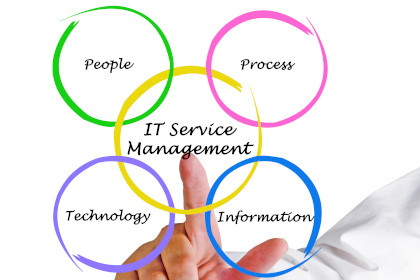Sitexs works closely with you to understand your goals and vision, to support your entire IT service management. There is no start with a "canned" course of action – each IT organization is individual and each client has unique requirements.

IT Service Delivery
With certifications in ITIL® 4 and ITIL® V3, I manage and control service delivery on behalf of your organization.
Value Co-Creation
True value is always co-created. Consumers get exactly what they want and have a hand in making it happen.
Transition Management
Service solutions must be transferred to live operations smoothly and with an appropriate level of maturity.
Agile Service Management
Inspired by agile thinking, the focus must be on the consumer in order to provide efficient services.
Hybrid Project Management
The essence is to combine waterfall and agile techniques in a way that makes them beneficial in the big picture.
Service Operations
Agility, interconnected collaboration, and a shift-left approach are essential components of modern IT operations.
IT Service Delivery
Providing services for ITSM is intense, comprehensive, and highly collaborative. Service delivery management therefore needs a holistic approach.
A pronounced consumer and service orientation is fundamental, both externally and internally: Business processes must be available to consumers in a user-friendly and efficient manner. Employees of internal IT departments are treated like customers themselves. Fast and well-directed stakeholder communication, especially in escalation management, is a key element here.
The integration of new customers and new IT services is characterized by a focus on value co-creation, simple and practical solutions, and the promotion of an agile and iterative approach. Modern concepts for system-supported process adjustments with continuous optimization must be developed.
The aim is to ensure the quality of service based on adjusted metrics of an appropriate SLA reporting, to continuously check it for value creation and to develop it with a perspective.
This is the only way your organization can achieve a real increase in efficiency with higher quality and can keep up with an ever-changing digital transformation.
Agile Service Management
The basic idea of agile service management is that the design and provision of services is based on agile principles to deliver services that facilitate customer outcomes when and how they are needed.
Lean, agile, stable, continuous, and "created together" are the dominant features, especially in high-velocity IT approaches. As a certified ITIL® 4 Managing Professional, I know how modern techniques such as Shift-left, Kanban, Swarming, Complexity Thinking, Toyota Kata or a safety culture (to name just a few) must be used appropriately.
Agile service management must encourage a continuous learning environment and promote better collaboration between development and operational teams by cross‐pollinating vocabulary and methods.
In doing so, one should work towards a consumer-centric mentality and create a strong and cooperative team culture at all levels.
"Being agile" is a philosophy, a set of guidelines to help you make day-to-day decisions, but doesn't tell you how to do a specific task. And I fully support you in raising your IT service management to the agile level.
Value Co-Creation
The Service Value System (SVS) of ITIL® 4 describes how all components and activities of an organization work together as a system to enable value co-creation of your digital products and it services.
Each organization's SVS interfaces with other organizations and forms an ecosystem. This, in turn, can facilitate value co-creation for that organization, its customers, and other stakeholders.
The 7 Guiding Principles, the Service Value Chain, and the ITIL® Practices all based on Continual Improvement form an effective framework in the SVS.
Focus on value, simplicity, and practicality as well as an iterative approach and transparent collaboration are certainly some of the most important key characteristics.
Understanding what the service consumer needs and wants, not just what the customer is saying, is part of driving outcomes and experiences for the service consumer. And this is particularly true when optimizing the customer journey.
Hybrid Project Management
Hybrid project management essentially combines traditional and agile project management techniques. The goal is to benefit from the strengths of each approach, and, at the same time avoid the weaknesses. On the one hand, structure, formality, and documentation are crucial in specific circumstances. Where flexibility, adaptability, and speed provide a significant advantage in others.
Project implementation should react flexibly to changes in the environment and scope of services. However, there should be no inaccuracies in time and budget planning, since the overall overview of the project can become confusing due to the constant reprioritization of tasks.
"Continued Business Justification", "Learn from Experience", "Manage by Stages" and "Tailor to Suit the Project Environment" are just some of the principles that form the basis for a successful implementation of a project.
Thanks to my many years of project experience and my PRINCE2® Agile Practitioner certification, I know how to set clear structures and apply agile procedures in a project-specific manner where they can also be used sensibly and profitably.
Transition Management
The development and improvement of capabilities for the transitioning of new and modified services into the adequately supported environment, including the release, planning, development, analysis, and implementation, is part of my area of competence.
Sitexs controls and supports all phases of:
- Large start-up management projects.
- International IT rollouts of multi-dimensional software systems.
- Transfer of new or updated IT practices/processes/functions.
- Transition of services between service providers.
- Change evaluation, management, and enablement.
- The retirement of services.
I use agile approaches and best practice guidelines to implement the transition project in constant balance with your IT service strategy and IT governance.
It requires a constant focus on the future operability and stability of the IT service. Therefore, during the transition, the progress of the operational maturity of the IT service is continuously reviewed with appropriate KPIs. In addition, the operating teams will be thoroughly trained.
Rest assured that no matter how simple or complicated the transition is, the necessary time and effort will be spent to make it a future success.
Service Operations
Today's IT teams are expected to ensure stability, security, and efficiency in increasingly dynamic and interconnected environments. With an end-to-end view, Sitexs creates operational stability to simultaneously support new initiatives and deliver value creation.
This is done by:
- Constantly monitoring the configuration items and services to filter and categorize events and decide on appropriate actions.
- Recovering IT services to the user as quickly as possible after an incident.
- Minimizing the impact of incidents that cannot be prevented.
- Day-to-day routine tasks as well as monitoring and controlling the IT services and their underlying infrastructure.
- Managing the IT infrastructure.
- Using agile techniques, focused on a service and customer oriented mindset
In particular, the focus is on proactively identifying issues before they emerge. This is done by performing continuous operation tasks to derive trends in system behavior and system performance. This includes analyzing the service support KPIs.
The aim is an efficient and effective provisioning of support structures for your IT services.

With the experience of many years in international IT projects, I provide my services worldwide - either with intelligent remote access or onsite.
Standardized procedures, principles, policies and mechanism for the distribution of tasks, problem solving, communication and collaboration between globally distributed partner, is the fundament to create and deliver IT services seamlessly to multinational customers.
Important characteristics to consider in Global Delivery Models:
- Division of tasks into most possible independent modules. The final service will be integrated so that the client does not recognize the different origins of the modules.
- Focus on standards and reference models for process optimization (e.g. ITIL®, PRINCE2® Agile).
- Strong customer focus, presence onsite directly at the customer, close cooperation between onshore and offshore teams.
Sitexs distinguishes by integrated methodical skills.
To address challenging border situations appropriately, Sitexs considers the ability to procure, to develop and to exploit knowledge successfully as a key factor.
- I collect, structure, edit, store, and re-use information, and interpret results of manufacturing processes correctly and present it in an appropriate form.
- Appropriate use of problem-solving techniques.
- Create problem-solving processes, e.g. project management.

Official Certificates:
- ITIL® 4 Managing Professional
Contains:
- ITIL® 4 Specialist „Create, Deliver & Support“ (CDS)
- ITIL® 4 Specialist „Drive Stakeholder Value“ (DSV)
- ITIL® 4 Specialist „High Velocity IT“ (HVIT)
- ITIL® 4 Strategist „Direct, Plan & Improve“ (DPI) - PRINCE2® Agile Practitioner
- PRINCE2® Practitioner
- PRINCE2® Foundation
- COBIT5® Foundation
- ITIL® V3 Expert in IT Service Management
- ITIL® V3 Managing Across the LifeCycle
- ITIL® V3 Continual Service Improvement
- ITIL® V3 Service Operation
- ITIL® V3 Service Transition
- ITIL® V3 Service Design
- ITIL® V3 Service Strategy
- ITIL® V3 Foundation

The provision of services for ITSM is intense, thorough, and highly collaborative.
|
Sitexs works closely with you to understand your goals and vision, to develop your entire IT service management. |
|
|
There is no start with a "canned" course of action – each IT organization is individually and each client has unique requirements. If you are not happy with the delivered work, Sitexs isn't either. |
|
|
Best practice guidelines are used to implement service management, service support, and service delivery in constant balance with the IT service strategy and IT governance. |
|
|
Guidance is offered on the combination of roles and responsibilities, the usage of checklists and tools to support ITSM effectively, as well as the prevention of conflicts between ITIL® priorities. |
|
|
Service has to be made measureable. The business perspective of service quality will clearly be defined, controlled and measured to manage improvements at running support structure. |

|
Customer-orientedI believe in client focus and loyalty through providing quality solutions coupled with commitment in a teamwork environment. |
|
|
Going the extra mileI consistently review and manage customer expectations in conjunction with outstanding personal service. |
|
|
Agile"Being agile" is a philosophy. Even under the most difficult conditions, I am extremely focussed, committed as well as flexible. |
